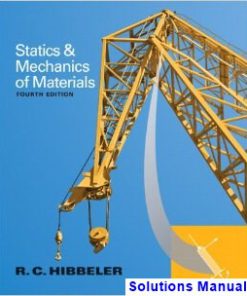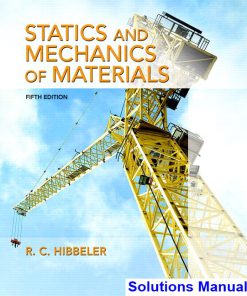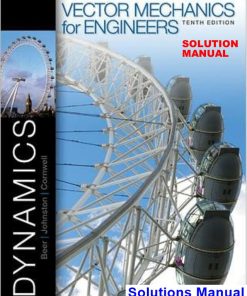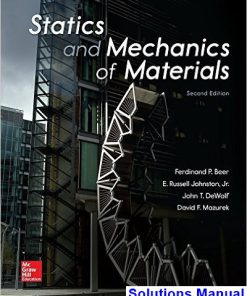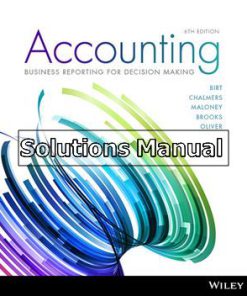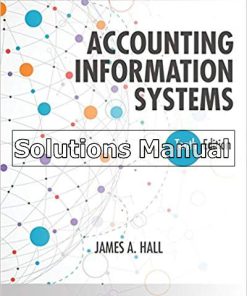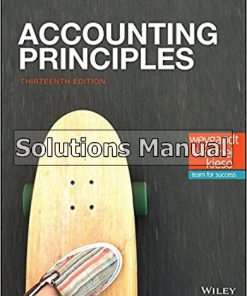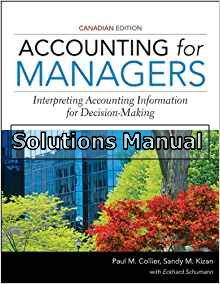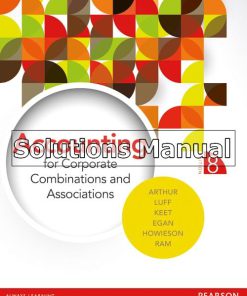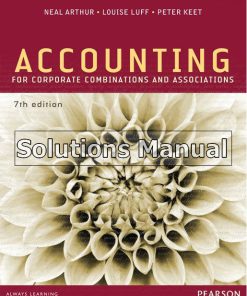Vector Mechanics for Engineers Statics and Dynamics 11th Edition Beer Solutions Manual
$26.50$50.00 (-47%)
Vector Mechanics for Engineers Statics and Dynamics 11th Edition Beer Solutions Manual.
You may also like
Instant download Vector Mechanics for Engineers Statics and Dynamics 11th Edition Beer Solutions Manual pdf docx epub after payment.

Product Details:
- ISBN-10 : 1259220494
- ISBN-13 : 978-1259220494
- Author:
A primary objective in a first course in mechanics is to help develop a student’s ability first to analyze problems in a simple and logical manner, and then to apply basic principles to their solutions. A strong conceptual understanding of these basic mechanics principles is essential for successfully solving mechanics problems. This 11th edition of Vector Mechanics for Engineers by Beer/Johnston/Mazurek/Cornwell will help instructors achieve these goals.
Continuing in the spirit of its successful previous editions, the 11th edition provides conceptually accurate and thorough coverage together with a significant refreshment of the exercise sets and online delivery of homework problems to your students. This edition has undergone a complete rewrite to modernize and streamline the language through the text. Over 650 of the homework problems in the text are new or revised. One of the characteristics of the approach used in this book is that mechanics of particles is clearly separated from the mechanics of rigid bodies. This approach makes it possible to consider simple practical applications at an early stage and to postpone the introduction of the more difficult concepts.
Table of contents:
INTRODUCTION 1 1.1 What Is Mechanics? 2 1.2 Fundamental Concepts and Principles 2 1.3 Systems of Units 5 1.4 Conversion from One System of Units to Another 10 1.5 Method of Problem Solution 11 1.6 Numerical Accuracy 13 STATICS OF PARTICLES 15 2.1 Introduction 16 Forces in a Plane 16 2.2 Force on a Particle---Resultant of Two Forces 16 2.3 Vectors 17 2.4 Addition of Vectors 18 2.5 Resultant of Several Concurrent Forces 20 2.6 Resolution of a Force into Components 21 2.7 Rectangular Components of a Force. Unit Vectors 27 2.8 Addition of Forces by Summing x and y Components 30 2.9 Equilibrium of a Particle 35 2.10 Newton's First Law of Motion 36 2.11 Problems Involving the Equilibrium of a Particle----Free-Body Diagrams 36 Forces in Space 45 2.12 Rectangular Components of a Force in Space 45 2.13 Force Defined by Its Magnitude and Two Points on Its Line of Action 48 2.14 Addition of Concurrent Forces in Space 49 2.15 Equilibrium of a Particle in Space 57 Review and Summary for Chapter 2 64 Review Problems 67 Computer Problems 69 RIGID BODIES: EQUIVALENT SYSTEMS OF FORCES 73 3.1 Introduction 74 3.2 External and Internal Forces 74 3.3 Principle of Transmissibility. Equivalent Forces 75 3.4 Vector Product of Two Vectors 77 3.5 Vector Products Expressed in Terms of Rectangular Components 79 3.6 Moment of a Force about a Point 81 3.7 Varignon's Theorem 83 3.8 Rectangular Components of the Moment of a Force 83 3.9 Scalar Product of Two Vectors 93 3.10 Mixed Triple Product of Three Vectors 95 3.11 Moment of a Force about a Given Axis 97 3.12 Moment of a Couple 107 3.13 Equivalent Couples 108 3.14 Addition of Couples 110 3.15 Couples Can Be Represented by Vectors 110 3.16 Resolution of a Given Force Into a Force at One and a Couple 111 3.17 Reduction of a System of Forces to One Force and One Couple 122 3.18 Equivalent Systems of Forces 123 3.19 Equipollent Systems of Vectors 124 3.20 Further Reduction of a System of Forces 124 3.21 Reduction of a System of Forces to a Wrench 127 Review and Summary for Chapter 3 146 Review Problems 151 Computer Problems 153 EQUILIBRIUM OF RIGID BODIES 157 4.1 Introduction 158 4.2 Free-Body Diagram 159 Equilibrium in Two Dimensions 160 4.3 Reactions at Supports and Connections for a Two-Dimensional Structure 160 4.4 Equilibrium of a Rigid Body in Two Dimensions 162 4.5 Statically Indeterminate Reactions. Partial Constraints 164 4.6 Equilibrium of a Two-Force Body 183 4.7 Equilibrium of a Three-Force Body 184 Equilibrium in Three Dimensions 191 4.8 Equilibrium of a Rigid Body in Three Dimensions 191 4.9 Reactions at Supports and Connections for a Three-Dimensional Structure 191 Review and Summary for Chapter 4 211 Review Problems 213 Computer Problems 215 DISTRIBUTED FORCES: CENTROIDS AND CENTERS OF GRAVITY 219 5.1 Introduction 220 Areas and Lines 220 5.2 Center of Gravity of a Two-Dimensional Body 220 5.3 Centroids of Areas and Lines 222 5.4 First Moments of Areas and Lines 223 5.5 Composite Plates and Wires 226 5.6 Determination of Centroids by Integration 236 5.7 Theorems of Pappus-Guldinus 238 5.8 Distributed Loads on Beams 248 5.9 Forces on Submerged Surfaces 249 Volumes 259 5.10 Center of Gravity of a Three-Dimensional Body---Centroid of a Volume 259 5.11 Composite Bodies 262 5.12 Determination of Centroids of Volumes by Integration 262 Review and Summary for Chapter 5 274 Review Problems 278 Computer Problems 281 ANALYSIS OF STRUCTURES 284 6.1 Introduction 285 Trusses 286 6.2 Definition of a Truss 286 6.3 Simple Trusses 288 6.4 Analysis of Trusses by the Method of Joints 289 6.5 Joints under Special Loading Conditions 291 6.6 Space Trusses 293 6.7 Analysis of Trusses by the Method of Sections 303 6.8 Trusses Made of Several Simple Trusses 304 Frames and Machines 315 6.9 Structures Containing Multiforce Members 315 6.10 Analysis of a Frame 315 6.11 Frames Which Cease to Be Rigid When Detached from Their Supports 316 6.12 Machines 331 Review and Summary for Chapter 6 343 Review Problems 346 Computer Problems 349 FORCES IN BEAMS AND CABLES 353 7.1 Introduction 354 7.2 Internal Forces in Members 354 Beams 361 7.3 Various Types of Loading and Support 361 7.4 Shear and Bending Moment in a Beam 362 7.5 Shear and Bending-Moment Diagrams 364 7.6 Relations among Load, Shear, and Bending Moment 372 Cables 383 7.7 Cables with Concentrated Loads 383 7.8 Cables with Distributed Loads 384 7.9 Parabolic Cable 385 7.10 Catenary 394 Review and Summary for Chapter 7 402 Review Problems 405 Computer Problems 408 FRICTION 411 8.1 Introduction 412 8.2 The Laws of Dry Friction. Coefficients of Friction 412 8.3 Angles of Friction 415 8.4 Problems Involving Dry Friction 416 8.5 Wedges 431 8.6 Square-Threaded Screws 431 8.7 Journal Bearings--Axle Friction 440 8.8 Thrust Bearings--Disk Friction 442 8.9 Wheel Friction--Rolling Resistance 443 8.10 Belt Friction 450 Review and Summary for Chapter 8 461 Review Problems 464 Computer Problems 467 DISTRIBUTED FORCES: MOMENTS OF INERTIA 471 9.1 Introduction 472 Moments of Inertia of Areas 473 9.2 Second Moment, or Moment of Inertia, of an Area 473 9.3 Determination of the Moment of Inertia of an Area by Integration 474 9.4 Polar Moment of Inertia 475 9.5 Radius of Gyration of an Area 476 9.6 Parallel-Axis Theorem 483 9.7 Moments of Inertia of Composite Areas 484 9.8 Product of Inertia 497 9.9 Principal Axes and Principal Moments of Inertia 498 9.10 Mohr's Circle for Moments and Products of Inertia 506 Moments of Inertia of Masses 512 9.11 Moment of Inertia of a Mass 512 9.12 Parallel-Axis Theorem 514 9.13 Moments of Inertia of Thin Plates 515 9.14 Determination of the Moment of Inertia of a Three-Dimensional Body by Integration 516 9.15 Moments of Inertia of Composite Bodies 516 9.16 Moment of Inertia of a Body with Respect to an Arbitrary Axis through O-- Mass Products of Inertia 531 9.17 Ellipsoid of Inertia. Principal Axes of Inertia 532 9.18 Determination of the Principal Axes and Principal Moments of Inertia of a Body of Arbitrary Shape 534 Review and Summary for Chapter 9 545 Review Problems 551 Computer Problems 554 METHOD OF VIRTUAL WORK 557 10.1 Introduction 558 10.2 Work of a Force 558 10.3 Principle of Virtual Work 561 10.4 Applications of the Principle of Virtual Work 562 10.5 Real Machines. Mechanical Efficiency 564 10.6 Work of a Force during a Finite Displacement 578 10.7 Potential Energy 580 10.8 Potential Energy and Equilibrium 581 *10.9 Stability of Equilibrium 582 Review and Summary for Chapter 10 592 Review Problems 595 Computer Problems 597 KINEMATICS OF PARTICLES 601 11.1 Introduction to Dynamics 602 Rectilinear Motion of Particles 603 11.2 Position, Velocity, and Acceleration 603 11.3 Determination of the Motion of a Particle 607 11.4 Uniform Rectilinear Motion 616 11.5 Uniformly Accelerated Rectilinear Motion 617 11.6 Motion of Several Particles 618 11.7 Graphical Solution of Rectilinear-Motion Problems 630 11.8 Other Graphical Methods 631 Curvilinear Motion of Particles 641 11.9 Position Vector, Velocity, and Acceleration 641 11.10 Derivatives of Vector Functions 643 11.11 Rectangular Components of Velocity and Acceleration 645 11.12 Motion Relative to a Frame in Translation 646 11.13 Tangential and Normal Components 663 11.14 Radial and Transverse Components 666 Review and Summary for Chapter 11 680 Review Problems 684 Computer Problems 687 KINETICS OF PARTICLES: NEWTON'S SECOND LAW 691 12.1 Introduction 692 12.2 Newton's Second Law of Motion 693 12.3 Linear Momentum of a Particle---Rate of Change of Linear Momentum 694 12.4 Systems of Units 695 12.5 Equations of Motion 697 12.6 Dynamic Equilibrium 699 12.7 Angular Momentum of a Particle---Rate of Change of Angular Momentum 718 12.8 Equations of Motion in Terms of Radial and Transverse Components 719 12.9 Motion under a Central Force--Conservation of Angular Momentum 720 12.10 Newton's Law of Gravitation 721 12.11 Trajectory of a Particle under a Central Force 731 12.12 Application to Space Mechanics 732 12.13 Kepler's Laws of Planetary Motion 735 Review and Summary for Chapter 12 744 Review Problems 748 Computer Problems 751 KINETICS OF PARTICLES: ENERGY AND MOMENTUM METHODS 755 13.1 Introduction 756 13.2 Work of a Force 756 13.3 Kinetic Energy of a Particle. Principle of Work and Energy 760 13.4 Applications of the Principle of Work and Energy 762 13.5 Power and Efficiency 763 13.6 Potential Energy 781 13.7 Conservative Forces 783 13.8 Conservation of Energy 784 13.9 Motion under a Conservative Central Force?Application to Space Mechanics 786 13.10 Principle of Impulse and Momentum 805 13.11 Impulsive Motion 808 13.12 Impact 820 13.13 Direct Central Impact 820 13.14 Oblique Central Impact 823 13.15 Problems Involving Energy and Momentum 826 Review and Summary for Chapter 13 842 Review Problems 848 Computer Problems 851 SYSTEMS OF PARTICLES 855 14.1 Introduction 856 14.2 Application of Newton's Laws to the Motion of a System of Particles-- Effective Forces 856 14.3 Linear and Angular Momentum of a System of Particles 859 14.4 Motion of the Mass Center of a System of Particles 860 14.5 Angular Momentum of a System of Particles about Its Mass Center 862 14.6 Conservation of Momentum for a System of Particles 864 14.7 Kinetic Energy of a System of Particles 873 14.8 Work-Energy Principle. Conservation of Energy for a System of Particles 875 14.9 Principle of Impulse and Momentum for a System of Particles 875 14.10 Variable Systems of Particles 886 14.11 Steady Stream of Particles 886 14.12 Systems Gaining or Losing Mass 889 Review and Summary for Chapter 14 904 Review Problems 908 Computer Problems 911 KINEMATICS OF RIGID BODIES 915 15.1 Introduction 916 15.2 Translation 918 15.3 Rotation about a Fixed Axis 919 15.4 Equations Defining the Rotation of a Rigid Body about a Fixed Axis 922 15.5 General Plane Motion 932 15.6 Absolute and Relative Velocity in Plane Motion 934 15.7 Instantaneous Center of Rotation in Plane Motion 945 15.8 Absolute and Relative Acceleration in Plane Motion 956 *15.9 Analysis of Plane Motion in Terms of a Parameter 958 15.10 Rate of Change of a Vector with Respect to a Rotating Frame 971 15.11 Plane Motion of a Particle Relative to a Rotating Frame?Coriolis Acceleration 973 15.12 Motion about a Fixed Point 984 15.13 General Motion 987 15.14 Three-Dimensional Motion of a Particle Relative to a Rotating Frame-- Coriolis Acceleration 998 15.15 Frame of Reference in General Motion 999 Review and Summary for Chapter 15 1011 Review Problems 1018 Computer Problems 1021 PLANE MOTION OF RIGID BODIES: FORCES AND ACCELERATIONS 1025 16.1 Introduction 1026 16.2 Equations of Motion for a Rigid Body 1027 16.3 Angular Momentum of a Rigid Body in Plane Motion 1028 16.4 Plane Motion of a Rigid Body. d'Alembert's Principle 1029 16.5 A Remark on the Axioms of the Mechanics of Rigid Bodies 1030 16.6 Solution of Problems Involving the Motion of a Rigid Body 1031 16.7 Systems of Rigid Bodies 1032 16.8 Constrained Plane Motion 1051 Review and Summary for Chapter 16 1073 Review Problems 1075 Computer Problems 1078 PLANE MOTION OF RIGID BODIES: ENERGY AND MOMENTUM METHODS 1081 17.1 Introduction 1082 17.2 Principle of Work and Energy for a Rigid Body 1082 17.3 Work of Forces Acting on a Rigid Body 1083 17.4 Kinetic Energy of a Rigid Body in Plane Motion 1084 17.5 Systems of Rigid Bodies 1085 17.6 Conservation of Energy 1086 17.7 Power 1087 17.8 Principle of Impulse and Momentum for the Plane Motion of a Rigid Body 1104 17.9 Systems of Rigid Bodies 1107 17.10 Conservation of Angular Momentum 1107 17.11 Impulsive Motion 1120 17.12 Eccentric Impact 1120 Review and Summary for Chapter 17 1134 Review Problems 1138 Computer Problems 1141 KINETICS OF RIGID BODIES IN THREE DIMENSIONS 1145 18.1 Introduction 1146 18.2 Angular Momentum of a Rigid Body in Three Dimensions 1147 18.3 Application of the Principle of Impulse and Momentum to the Three-Dimensional Motion of a Rigid Body 1151 18.4 Kinetic Energy of a Rigid Body in Three Dimensions 1152 18.5 Motion of a Rigid Body in Three Dimensions 1165 18.6 Euler's Equations of Motion. Extension of d'Alembert's Principle to the Motion of a Rigid Body in Three Dimensions 1166 18.7 Motion of a Rigid Body about a Fixed Point 1167 18.8 Rotation of a Rigid Body about a Fixed Axis 1168 18.9 Motion of a Gyroscope--Eulerian Angles 1183 18.10 Steady Precession of a Gyroscope 1185 18.11 Motion of an Axisymmetrical Body under No Force 1186 Review and Summary for Chapter 18 1199 Review Problems 1204 Computer Problems 1208 MECHANICAL VIBRATIONS 1213 19.1 Introduction 1214 Vibrations without Damping 1214 19.2 Free Vibrations of Particles--Simple Harmonic Motion 1214 19.3 Simple Pendulum (Approximate Solution) 1218 19.4 Simple Pendulum (Exact Solution) 1219 19.5 Free Vibrations of Rigid Bodies 1228 19.6 Application of the Principle of Conservation of Energy 1240 19.7 Forced Vibrations 1251 Damped Vibrations 1261 19.8 Damped Free Vibrations 1261 19.9 Damped Forced Vibrations 1264 19.10 Electrical Analogues 1265 Review and Summary for Chapter 19 1277 Review Problems 1282 Computer Problems 1285 Appendix FUNDAMENTALS OF ENGINEERING EXAMINATION 1289 Photo Credits 1291 Index 1293 Answers to Problems 1305
People also search:
Vector Mechanics for Engineers Statics and Dynamics 11th Edition Beer
Vector Mechanics for Engineers Statics and Dynamics 11th Edition
Vector Mechanics for Engineers Statics and Dynamics
what is engineering mechanics statics
|
what is engineering science and mechanics
|
|
what is static in engineering mechanics
|


